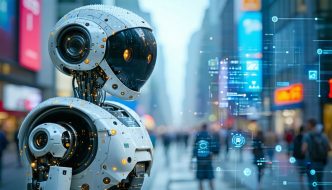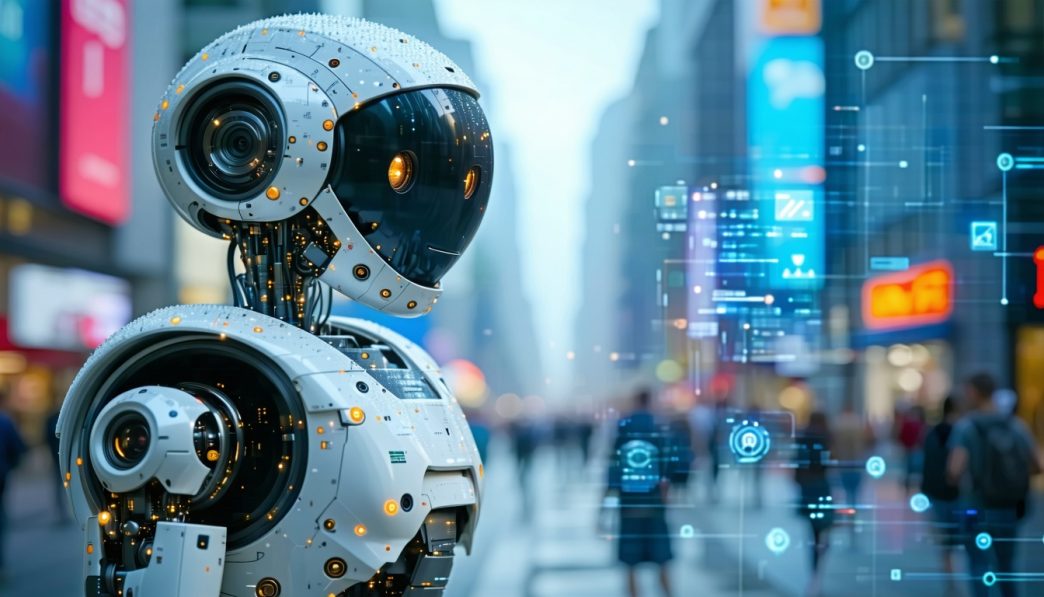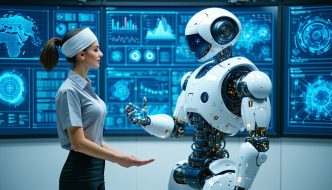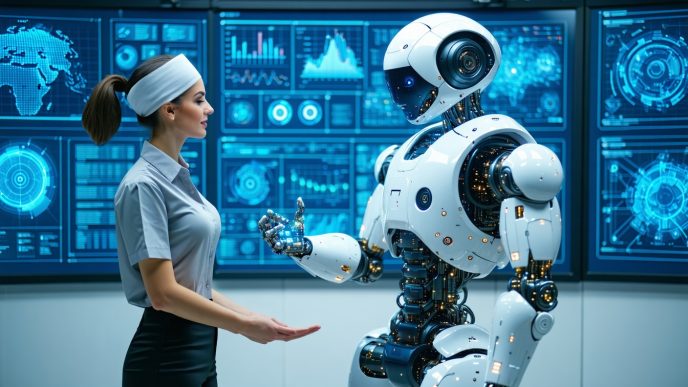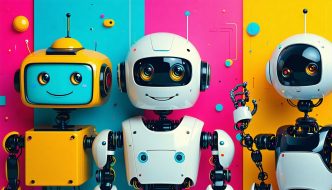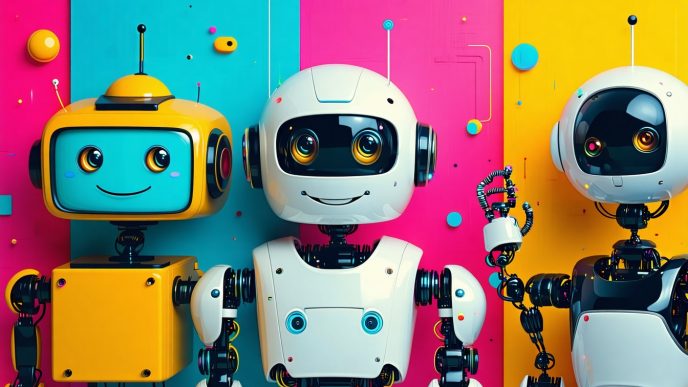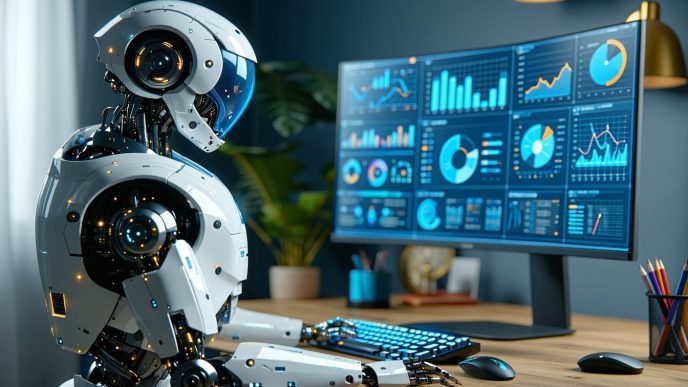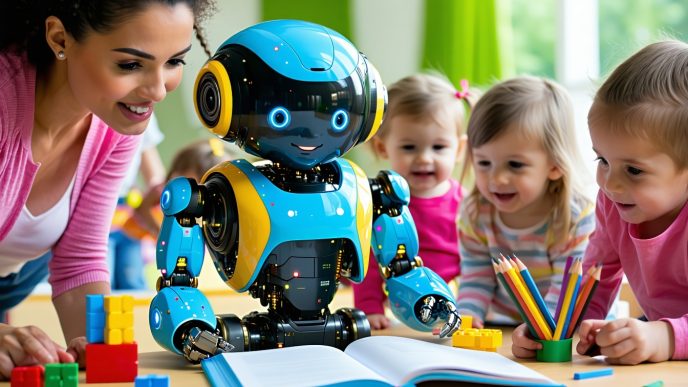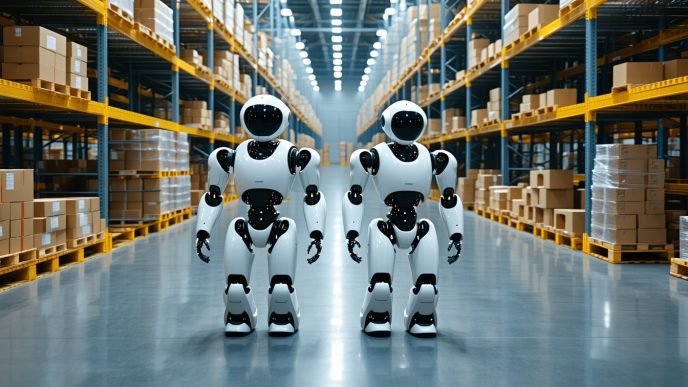Understanding Humanoid Robots
What Are Humanoid Robots?
Humanoid robots are machines designed to resemble the human body in appearance and behavior. They feature a head, torso, arms, and legs, mimicking human movements and interactions. These robots utilize advanced technologies such as sensors, artificial intelligence, and machine learning to perform tasks that require human-like dexterity and cognitive processing.
| Feature | Description |
|---|---|
| Structure | Human-like design, with limbs and facial features |
| Technology | Equipped with sensors, AI, and learning capabilities |
| Purpose | Perform tasks in various environments, from homes to industries |
Examples of humanoid robots being developed include the Tesla Optimus robot and the Ameca robot by Engineered Arts.
Applications of Humanoid Robots
Humanoid robots have a wide range of applications across different fields. They can be utilized in various settings, significantly enhancing productivity and services. Some common applications include:
| Application Area | Examples |
|---|---|
| Home Assistance | Humanoid robots for home use |
| Education | Teaching and tutoring in classrooms |
| Healthcare | Assistance in elder care and rehabilitation humanoid robots in healthcare |
| Security | Surveillance and patrolling humanoid robots for security |
| Customer Service | Interacting with customers in retail |
Privacy Concerns with Humanoid Robots
With the increasing presence of humanoid robots in personal and public spaces, privacy concerns have emerged. The capacity of humanoid robots to gather data raises questions about data collection and usage.
Data collected by these robots can include:
- Voice recordings during interactions
- Video footage for navigation and task performance
- Personal preferences based on user interactions
This data collection presents challenges in terms of privacy and security. Users may worry about who has access to their data and how it is being used. It is essential to explore these issues thoroughly when discussing the intersection of humanoid robots and privacy.
By understanding the definition, applications, and privacy concerns associated with humanoid robots, individuals can better navigate the complexities of integrating these machines into their lives.
Data Collection by Humanoid Robots
Humanoid robots are increasingly integrated into everyday life, which raises questions about the types of data they collect, how they gather this information, and the subsequent storage and usage of that data. Understanding these aspects is crucial for addressing the concerns surrounding humanoid robots and privacy.
Types of Data Collected
Humanoid robots collect a variety of data types to function effectively in their intended roles. This data generally falls into several categories:
| Data Type | Description |
|---|---|
| Personal Data | Includes user profiles, preferences, and habits. |
| Environmental Data | Information about surroundings and conditions. |
| Interaction Data | Records of user interactions, commands, and responses. |
| Performance Data | Data related to the robot’s operational efficiency and task completion. |
Methods of Data Collection
The methods used by humanoid robots to collect data can vary based on their design and functionality. Common methods include:
| Method | Description |
|---|---|
| Sensors | Devices that detect environmental factors, such as temperature, light, and motion. |
| Cameras | Used for visual data collection, allowing robots to recognize faces and navigate surroundings. |
| Voice Recognition Systems | Captures audio data for processing user commands and understanding natural language. |
| Wi-Fi and Bluetooth | Facilitates data exchange with other devices and cloud servers. |
Storage and Usage of Data
The data collected by humanoid robots requires proper management to ensure both functionality and privacy. Here’s an overview of how this data is typically stored and used:
| Storage Type | Description |
|---|---|
| Local Storage | Data is saved directly on the robot’s hardware, allowing for rapid access and processing. |
| Cloud Storage | Data is sent to remote servers for enhanced storage capacity and analysis. This can lead to better performance and updates. |
The data collected can be used for various purposes such as improving robot functionality, tailoring user experiences, and developing future technologies. It is essential for developers to implement clear data handling policies to protect user privacy. For more insights on the implications of data collection, consider exploring the sections on privacy risks and legal considerations.
Implications of Data Collection
As humanoid robots become more integrated into daily life, the implications of their data collection practices raise several significant issues. These revolve around privacy risks and legal, ethical considerations.
Privacy Risks and Concerns
Humanoid robots are designed to monitor their environments, which often involves collecting sensitive data about individuals in the home. The types of data gathered may include audio recordings, visual imagery, and even biometric information. Such comprehensive data collection poses potential privacy risks.
| Type of Data Collected | Description |
|---|---|
| Personal Conversations | Robots may record interactions, leading to potential misuse of audio data. |
| Visual Data | Cameras can capture images and videos of inhabitants, affecting privacy. |
| Biometric Data | Information like fingerprints or facial recognition data can be misused. |
The widespread adoption of these robots can lead to unauthorized access to personal information. Consumers may be unaware of how their data is being used or stored, increasing the risk of breaches and misuse.
Legal and Ethical Considerations
The legal framework surrounding data privacy evolves slowly, often lagging behind technological advancements. Humanoid robots and privacy become intertwined concerns that need addressing through regulation. Current laws may not adequately protect data rights for users interacting with these robots.
Key areas include:
- User Consent: Many humanoid robots require users to agree to terms of service that aren’t always transparent. Users may unknowingly permit extensive data collection.
- Data Ownership: Questions about who controls the collected data arise. Are the users the owners, or do manufacturers have rights to the data collected by their robots?
- Overall Security Measures: Laws governing data protection and cybersecurity are critical in ensuring that collected data remains secure.
An evolving landscape for regulations is necessary, especially in areas related to data ethics. As humanoid robots increase in functionality and use, guidelines must adapt to protect user privacy comprehensively. Familiarizing oneself with the legal implications can aid users in understanding their rights and responsibilities. For further insights, readers can check out our article on humanoid robot legal issues.
Securing Data Privacy
As the use of humanoid robots becomes more prevalent in households, securing the privacy of data collected by these machines is crucial. Ensuring that users feel safe and informed about their information is a key concern. This section discusses essential measures for data protection and the importance of user consent and control in maintaining privacy.
Data Protection Measures
Effective data protection measures help safeguard personal information collected by humanoid robots. These measures can involve both technological and procedural strategies. Here are some common data protection protocols:
| Data Protection Measure | Description |
|---|---|
| Encryption | Converting data into a secure format to prevent unauthorized access. |
| Access Controls | Implementing user authentication to ensure that only authorized individuals can access data. |
| Anonymization | Removing personally identifiable information (PII) from data to protect user identity. |
| Regular Audits | Conducting periodic reviews of data handling practices to identify and rectify vulnerabilities. |
| Secure Storage | Using protected servers and databases to store data safely. |
Implementing these measures not only builds trust but also aligns with legal requirements regarding data protection. For additional reading, see our article on humanoid robots and privacy.
User Consent and Control
User consent is a foundational aspect of data privacy concerning humanoid robots. Individuals must be informed about the data being collected and how it will be used. Providing clear options for consent allows users to maintain control over their information. Users should be given the following options:
- Opt-in/Opt-out Mechanisms: Users can choose to participate in data collection or decline participation.
- Transparency: Clear disclosures about data collection practices and usage should be available.
- Data Access: Users should have the ability to access their collected data and make requests for corrections or deletions.
- Privacy Settings: Customizable settings that allow users to adjust their level of data sharing.
Creating a robust user consent framework enhances the ethical use of data and empowers individuals in their interactions with humanoid robots. For more on user management, check out our article on what owners need to know.
Future Trends
Advancements in Humanoid Robot Technology
The field of humanoid robots is rapidly evolving, with notable advancements that enhance their functionality and integration into everyday life. Recent innovations focus on improving their capabilities in areas such as mobility, interaction, and intelligence.
One major development is the improvement of locomotion systems, enabling humanoid robots to navigate complex environments more effectively. These enhancements include:
| Feature | Description |
|---|---|
| Enhanced Sensors | Modern robots are equipped with advanced sensor technology to better perceive their surroundings. |
| AI Integration | Incorporation of sophisticated AI models allows for more adaptive and intuitive interactions. |
| Emotion Recognition | Robots have the capacity to recognize human emotions, which can improve user interaction and companionship. |
| Voice Interfaces | Advancements in voice interfaces in humanoid robots provide more natural communication between humans and robots. |
Technological breakthroughs also focus on making humanoid robots more accessible for home use. Concepts like humanoid robots for home use are becoming increasingly relevant as manufacturers work on affordability and usability. Robots like the Tesla Optimus robot and Sanctuary AI Phoenix highlight this trend.
Evolving Data Privacy Regulations
As humanoid robots become prevalent in households, the topic of data privacy increasingly gains attention. Regulatory bodies are responding to privacy concerns related to the data collected by these robots. Implementing laws and regulations ensures that consumer data is handled responsibly and securely.
Key aspects of evolving data privacy regulations include:
| Regulation Aspect | Description |
|---|---|
| User Consent | Regulations now mandate that users must give explicit consent for data collection, ensuring transparency. |
| Data Minimization | Authorities are encouraging the principle of collecting only essential data needed for functionality. |
| User Control | Enhanced user control settings are being established, allowing individuals to manage their data preferences. |
With these regulations in mind, manufacturers are adapting their practices to align with compliance requirements. Understanding the implications of humanoid robots and privacy is crucial for users to make informed decisions regarding technology that interacts with their daily lives. As the technology continues to evolve, so will the interplay between innovation and privacy safeguarding, creating a roadmap for future development.
